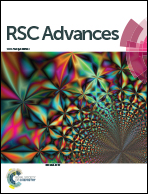Exploring the metabolic biomarkers and pathway changes in crucian under carbonate alkalinity exposure using high-throughput metabolomics analysis based on UPLC-ESI-QTOF-MS†
Abstract
The aims of this study is to explore the metabolomic biomarker and pathway changes in crucian under carbonate alkalinity exposures using high-throughput metabolomics analysis based on ultra-performance liquid chromatography-electrospray ionization-quadrupole time of flight-tandem mass spectrometry (UPLC-ESI-QTOF-MS) for carrying out adaptive evolution of fish in environmental exposures and understanding molecular physiological mechanisms of saline–alkali tolerance in fishes. Under 60 day exposure management, the UPLC-ESI-QTOF-MS technology, coupled with a pattern recognition approach and metabolic pathway analysis, was utilized to give insight into the metabolic biomarker and pathway changes. In addition, biochemical parameters in response to carbonate alkalinity in fish were detected for chronic impairment evaluation. A total of twenty-seven endogenous metabolites were identified to distinguish the biochemical changes in fish in clean water under exposure to different concentrations of carbonate alkalinity (CA); these mainly involved amino acid synthesis and metabolism, arachidonic acid metabolism, glyoxylate and dicarboxylate metabolism, pyruvate metabolism and the citrate cycle (TCA cycle). Compared with the control group, CA exposure increased the level of blood ammonia; TP; ALB; Gln in the liver and gills; GS; urea in blood, the liver and gills; CREA; CPS; Glu and LDH; and decreased the level of weight gain rate, oxygen consumption, discharge rate of ammonia, SOD, CAT, ALT, AST and Na+/K+-ATPase. At low concentrations, CA can change the normal metabolism of fish in terms of changing the osmotic pressure regulation capacity, antioxidant capacity, ammonia metabolism and liver and kidney function to adapt to the CA exposure environment. As the concentration of CA increases, various metabolic processes in crucian are inhibited, causing chronic damage to the body. The results show that the metabolomic strategy is a potentially powerful tool for identifying the mechanisms in response to different environmental exposomes and offers precious information about the chronic response of fish to CA.



 Please wait while we load your content...
Please wait while we load your content...